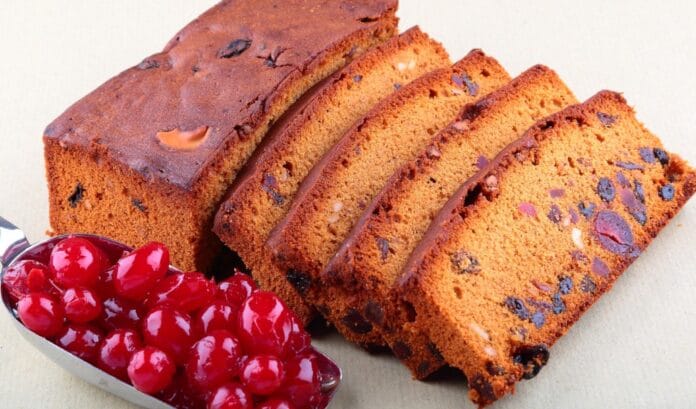Plum cake, a timeless holiday dessert, is an integral part of Christmas celebrations across the globe. In India, this rich and flavourful cake has become synonymous with the festive season, often bringing families together over its preparation and enjoyment.
Unlike its name suggests, traditional plum cake doesn’t necessarily contain fresh plums. Instead, it gets its name from the inclusion of dried fruits soaked in liquids such as rum, brandy, or even fruit juice for a non-alcoholic version.
This guide will walk you through the process of making the perfect plum cake recipe, step-by-step, with variations and tips for ensuring the best results.
What Makes Plum Cake a Timeless Holiday Dessert?
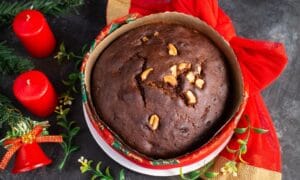
Plum cake has a long history, with its origins rooted in early European holiday traditions. The practice of soaking fruits in alcohol and incorporating them into cakes dates back to the 16th century.
This dessert symbolised abundance and prosperity, which made it a popular choice for Christmas and other festive occasions.
Over the years, the recipe has evolved to include a variety of flavours, from the traditional rum-soaked version to eggless and gluten-free alternatives.
What sets plum cake apart is its rich taste, derived from the combination of dried fruits, nuts, and warm spices like cinnamon and nutmeg.
The cake’s deep flavour develops further when aged, making it a preferred dessert for celebrations. Its association with Christmas, a time of joy and giving, has solidified its status as a timeless holiday treat, loved by generations.
How Do You Prepare the Dry Fruits for Plum Cake?
One of the most crucial steps in making a delicious plum cake is preparing the dry fruits. This process enhances the cake’s flavour, ensuring a moist and rich texture. Here’s how you can prepare your fruits:
1. Selection of Fruits: Use a mix of raisins, dates, apricots, cherries, and candied peels. You can also include nuts like almonds, cashews, and walnuts for added crunch.
2. Soaking the Fruits:
- Alcoholic Version: Soak your dry fruits in rum, brandy, or whisky for at least 1-2 weeks (longer if possible).
- Non-Alcoholic Version: Use orange juice, apple juice, or tea as a substitute. Soak the fruits for at least 24 hours for a similar effect.
3. Tips:
- Use an airtight container for soaking to retain moisture.
- Stir occasionally to ensure the fruits absorb the liquid evenly.
This step not only enriches the flavour but also softens the fruits, preventing them from becoming chewy or dry during baking.
What Ingredients Do You Need for a Perfect Plum Cake?
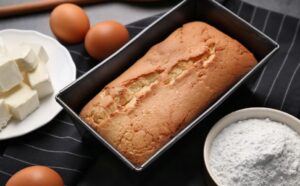
To make a perfect plum cake, having the right ingredients in the correct measurements is essential. Each component plays a specific role in creating the cake’s signature taste, texture, and festive appeal.
Below is a detailed list of ingredients along with their quantities:
Dry Ingredients
- All-purpose flour (maida): 1 ½ cups (180 g) – Provides structure to the cake.
- Baking powder: 1 teaspoon – Helps the cake rise and become light.
- Baking soda: ½ teaspoon – Enhances leavening and adds softness.
- Ground spices:
- Cinnamon: 1 teaspoon
- Nutmeg: ½ teaspoon
- Cloves (powdered): ¼ teaspoon
Wet Ingredients
- Eggs: 2 large eggs – Adds moisture and binds the batter. (For eggless: Use ½ cup (125 g) yogurt or 2 tablespoons of flaxseed gel.)
- Butter: ½ cup (113 g), softened – Provides richness and flavour.
- Brown sugar: ¾ cup (150 g) – Adds sweetness and a caramelised depth of flavour.
- Milk (optional): 2–3 tablespoons – Used to adjust batter consistency if needed.
Fruits and Nuts
- Soaked dry fruits: 1 cup (150 g) – Use a mix of raisins, dates, figs, apricots, and cherries. (If soaked in alcohol: Use ½ cup rum or brandy for soaking. For non-alcoholic, use orange juice.)
- Nuts: ½ cup (50 g) – Chopped almonds, cashews, and walnuts add crunch.
- Candied fruits and peels: ¼ cup (50 g) – Adds colour and a festive touch.
Optional Additions
- Vanilla extract: 1 teaspoon – Enhances the cake’s flavour.
- Orange zest or lemon zest: 1 teaspoon – Provides a hint of freshness and citrusy aroma.
- Dark caramel syrup: 2 tablespoons (optional) – Adds colour and a deeper flavour to the cake. (You can make this by melting sugar and adding water to create a syrup.)
How to Bake a Plum Cake? – Step by Step
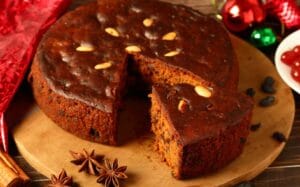
Baking a plum cake can seem intimidating, but by following these steps, you can achieve excellent results:
1. Preheat and Prepare
- Preheat your oven to 180°C (350°F).
- Grease and line a cake tin with parchment paper.
2. Mix the Dry Ingredients
- Sift flour, baking powder, baking soda, and spices into a bowl.
3. Cream Butter and Sugar
- Beat butter and sugar until light and fluffy.
- Add eggs (one at a time) or yogurt for an eggless option.
4. Combine the Mixtures
- Gradually fold the dry ingredients into the wet mixture.
- Add the soaked fruits and chopped nuts, ensuring they’re evenly distributed.
5. Bake the Cake
- Pour the batter into the prepared tin and bake for 45–60 minutes.
- Check doneness by inserting a toothpick into the centre.
6. Cool and Serve
- Allow the cake to cool completely before removing it from the tin.
- Optionally, brush with a glaze or dust with powdered sugar.
What Variations of Plum Cake Can You Try?
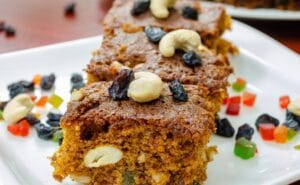
Plum cake recipes offer plenty of room for experimentation, catering to various preferences:
- Kerala-Style Plum Cake: A traditional recipe often featuring deeply soaked fruits and Indian spices.
- Eggless Plum Cake: Use yogurt, mashed bananas, or flaxseed gel as egg substitutes.
- Alcohol-Free Plum Cake: Soak fruits in fresh juice or tea for a non-alcoholic version.
- Gluten-Free Plum Cake: Use almond flour or gluten-free baking mix for those with dietary restrictions.
Each variation has its own unique charm, making plum cake a versatile dessert.
How Do You Make Plum Cake Without Alcohol?
Creating a non-alcoholic version of plum cake is straightforward and just as delicious:
Soaking Alternatives:
- Replace alcohol with orange juice, apple juice, or brewed tea.
- Let the fruits soak for 24–48 hours in the fridge.
Maintaining Flavour:
- Add extra spices like ginger and cloves for depth.
- Use citrus zest to enhance the freshness.
This version is family-friendly and suitable for everyone, making it an excellent choice for non-alcoholic celebrations.
Conclusion
Plum cake is more than just a dessert; it’s a cherished tradition that brings warmth and joy to festive celebrations.
By carefully selecting quality ingredients, soaking fruits perfectly, and following the step-by-step process, you can bake a rich, flavourful cake that’s bound to impress.
Whether you opt for the classic recipe, a Kerala-style variation, or an eggless version, the result will always be a delightful treat.
With its timeless appeal, plum cake is perfect for gifting, sharing, or enjoying with family during the holiday season. Start baking your plum cake today and create memories that last a lifetime!
